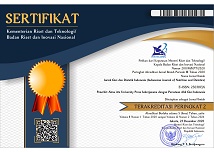Formulasi bubur bayi MPASI yang diperkaya hidrolisat protein ikan lele dumbo (Clarias gariepinus)
Abstract
ABSTRACT
Background: Malnutrition become the problem in Indonesia. Complementary feeding has the role in solving it. Most of commercial complementary feeding are enriched by vegetable protein, whereas animal protein has more complete amino acid and better digestibility. Unfortunately, consuming animal protein
often raises concern because of its allergenicity. Catfish (Clarias gariepinus) can be used as a source of high animal protein in the diet that may solve the nutritional problem after reduction of its allergen.
Objectives: To develope formulate of complementary feeding porridge enriched with hydrolized protein from catfish muscle.
Methods: This was experimental study. HPIL and HPIK was enzymatic hydrolized products of catfish using crude and commercial papain, respectively. Overall and partial hedonic test used 23 mothers as panelists, then selected formula were tested its acceptance by 9 babies using face scale. Nutrient content of porridge were analyzed for protein, carbohydrate, fat, protein, and water.
Results: Hydrolysis of catfish using papain made the changes in color, taste, and aroma. The bitter taste limited the uses, maximum amount was 25%. Porridge with the addition of HPIK were chosen by mothers and babies panelists, whereas HPIL did not. Protein content of formulated product were lower than commercial product, but carbohydrate and fat content were higher.
Conclusions: Porridge formula with addition of 25% HPIK my be developed as alternative product of complementary feeding.
KEYWORDS: protein, papain, catfish, protein hydrolisate, complementary feeding
ABSTRAK
Latar belakang: Kekurangan gizi masih menjadi masalah di Indonesia. MPASI memiliki peran penting dalam mengatasi masalah tersebut. MPASI pada umumnya diperkaya oleh protein nabati, padahal protein hewani mengandung asam amino dan daya cerna yang lebih baik. Namun demikian, protein hewani
meningkatkan risiko alergi pada bayi. Lele (Clarias gariepinus) dapat dijadikan alternatif sumber protein hewani karena ketersediaan yang banyak dan harganya yang murah. Diperlukan suatu teknologi untuk mengurangi tingkat alerginya dan formulasi yang tepat dibutuhkan agar dapat diterima oleh bayi.
Tujuan: Formulasi bubur bayi MPASI yang diperkaya hidrolisat protein ikan lele dumbo.
Metode: Jenis penelitian ini adalah eksperimental. HPIL dan HPIK merupakan hidrolisat protein ikan lele dumbo yang masing-masing dihidrolisis secara enzimatis menggunakan enzim papain kasar dan papain komersial. Uji kesukaan keseluruhan dan parsial menggunakan 23 panelis ibu, kemudian formula terpilih
diujikan daya terimanya oleh 9 bayi menggunakan skala raut muka. Uji nilai gizi bubur bayi meliputi kadar protein, karbohidrat, lemak, protein, dan air.
Hasil: Proses hidrolisis kimiawi protein ikan lele dumbo menggunakan enzim papain menyebabkan perubahan warna, rasa, dan aroma produk. Adanya perubahan sifat tersebut menyebabkan penambahannya ke dalam formulasi bubur MPASI hanya sampai kadar 25%. Di atas kadar tersebut, produk berasa pahit. Hasil uji sensoris produk formulasi HPIK dapat diterima oleh panelis ibu dan bayi, sedangkan produk HPIL tidak. Kandungan protein produk formulasi lebih rendah dibanding bubur komersial, namun kandungan karbohidrat dan lemak lebih tinggi.
Kesimpulan: Formula bubur bayi dengan penambahan 25% HPIK dapat dikembangkan menjadi alternatif produk MPASI.
KATA KUNCI: protein, papain, lele dumbo, hidrolisat protein, MPASI
Keywords
Full Text:
PDFReferences
Badan Penelitian dan Pengembangan Kesehatan Kementerian Kesehatan Republik Indonesia. RISKESDAS 2010. Jakarta; 2010.
Osundahunsi OF, Aworh OC. A preliminary study on the use of tempe-based formula as a weaning diet in Nigeria. Plant Foods Hum Nutr. 2002;57:365–76.
Babajide JM, Babajide SO, Uzochukwu S. Cassava-soy weaning food : Biological evaluation and effects on rat organs. Plant Foods Hum Nutr. 2001;56:167–73.
Wadud S, Abid H, Ara H, Kosar S, Shah WH. Production, quality evaluation and storage stability of vegetable protein-based baby foods.
;85:175–9.
Hoffman JR, Falvo MJ. Protein-which is best? J Sport Sci Med. 2004;3:118–30.
Widadi IR. Pembuatan dan karakterisasi hidrolisat protein dari ikan lele dumbo (Clarias gariepinus) menggunakan enzim papain. Institut
Pertanian Bogor; 2011.
Ersoy B, Yılmaz AB. Frozen storage of African catfish (Clarias gariepinus BURCHELL, 1822) mince balls. Turkish J Vet Anim Sci.
;27:827–32.
Aprilia V, Hati FS. Use of Crude and Commercial Papain for the Hydrolysis of Catfish ( Clarias gariepinus ) Protein to Reduce Allergenicity. The 16th Food Innovation Asia Conference 2014 [Internet]. Bangkok, Thailand; 2014. p. 34–43. Available from: agkb.lib.ku.ac.th/ku/
search_detail/dowload_digital_fi le/22673/34
Nilsang S, Lertsiri S, Suphantharika M, Assavanig A. Optimization of enzymatic hydrolysis of fish soluble concentrate y commercial proteases. J Food Eng. 2005;70:571–8.
Nasional BS. SNI Makanan Pendamping Air Susu Ibu (MP-ASI)-Bagian 1: Bubuk Instan. Jakarta; 2005.
Nicklaus S. Children ’ s acceptance of new foods at weaning . Role of practices of weaning and of food sensory properties. Appetite [Internet].
Elsevier Ltd; 2011;57(3):812–5. Available from: http://dx.doi.org/10.1016/j.appet.2011.05.321
Winarti S, Jariyah, Purnomo Y. Proses pembuatan VCO (virgin coconut oil ) secara enzimatis menggunakan papain kasar. J Teknol Pertan. 2007;8(2):136–41.
Guinard J. Sensory and consumer testing with children. Trends Food Sci Technol 11. 2001;11:273–83.
AOAC. Official of analysis of the association of official analytical chemistry. Airlington: AOAC Inc.; 1995.
Tanuja S, Viji P, Zynudheen AA, Joshy CG. Composition, functional properties and antioxidative activity of hydrolysates prepared
from the frame meat of Striped catfish (Pangasianodon hypophthalmus). Egypt J Biol. 2012;14:27–35.
Rutherfurd SM. Methodology for determining degree of hydrolysis of protein hydrolysates: a review. J AOAC Int. 2010;93(5):1515–22.
Theodore ANNE. Bioactive and functional properties of catfi sh protein hydrolysates and catfish protein isolates. University of Florida;
Sanni AI, Onilude AA, Ibidapo OT. Biochemical composition of infant weaning food fabricated from fermented blends of cereal and soybean.
Food Chem. 1999;65:35–9.
Amankwah EA, Barimah J, Nuamah AKM, Oldham JH, Nnaji CO. Formulation of weaning food from fermented maize, rice , soybean and
fishmeal. Pakistan J Nutr. 2009;8(11):1747–52.
Adenuga W. Nutritional and sensory profiles of sweet potato based infant weaning food fortified with cowpea and peanut. J Food Technol. 2010;8(5):223–8.
Menteri Kesehatan Republik Indonesia. Peraturan Menteri Kesehatan Republik Indonesia Nomor 75 Tahun 2013 tentang Angka Kecukupan Gizi yang Dianjurkan bagi Bangsa Indonesia. Jakarta; 2013.
DOI: http://dx.doi.org/10.21927/ijnd.2016.4(2).88-96
Refbacks
- There are currently no refbacks.
Indonesian Journal of Nutrition and Dietetics (IJND) indexed by:
 View My Stats
View My Stats



12.png)


























